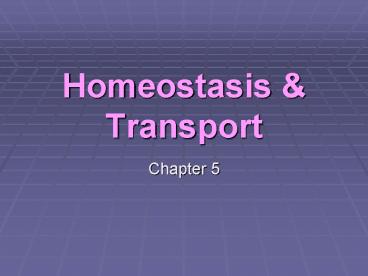Homeostasis - PowerPoint PPT Presentation
1 / 32
Title:
Homeostasis
Description:
Homeostasis & Transport Chapter 5 Passive Transport Section 5.1 Homeostasis? How do cell membranes help maintain homeostasis within a cell? By controlling what goes ... – PowerPoint PPT presentation
Number of Views:143
Avg rating:3.0/5.0
Title: Homeostasis
1
Homeostasis Transport
- Chapter 5
2
Passive Transport
- Section 5.1
3
Homeostasis?
- How do cell membranes help maintain homeostasis
within a cell? - By controlling what goes into and out of the cell.
4
Passive Transport
- The movement of materials across a cell membrane
WITHOUT the use of energy (ATP). - Four Types
- Diffusion
- Osmosis
- Facilitated Diffusion
- Ion Channels
5
Diffusion
- Movement of molecules from an area of high
concentration to an area of low concentration.
6
Diffusion through a Membrane
Cell membrane
Solute moves DOWN concentration gradient (HIGH
to LOW)
7
Concentration Gradient
- Difference in concentration of molecules across a
space (or cell membrane). - Down the gradient
- Movement from high to low concentration
8
Equilibrium
- When the concentration is EQUAL throughout the
space (or on each side of the cell membrane) - End of diffusion
- No NET movement, RANDOM movement still occurs
9
Diffusion of Liquids
10
Diffusion across a membrane
- Depends upon size, shape, and chemical makeup
- Easy to diffuse
- Small
- Nonpolar
11
Osmosis
- WATER diffusion across a membrane
- Down the gradient
- Hypotonic solution to hypertonic solution
- Osmosis
- animation
12
Osmosis
13
Hypotonic Solution
- The solute concentration is higher inside the
cell, the water concentration is higher outside
the cell. - Net movement Water into the cell
- May cause Cytolysis
14
Hypertonic Solution
- The solute concentration is higher outside the
cell, the water concentration is higher inside
the cell. - Net movement Water out of the cell
- May cause Plasmolysis
15
Isotonic Solution
- The solute and water concentrations are EQUAL on
both sides of the membrane. - Equilibrium
16
(No Transcript)
17
Osmosis in Red Blood Cells
Isotonic
Hypotonic
Hypertonic
18
hypotonic
hypertonic
isotonic
hypertonic
isotonic
hypotonic
19
Facilitated Diffusion
- Use of carrier proteins the assist diffusion
across a membrane. - Specific carrier proteins for specific molecules
(like glucose or amino acids) - Down the gradient
20
Diffusion via ion channels
- Use of membrane proteins to assist diffusion of
ions across a membrane - Channel is usually specific to 1 type of ion
- Common ions
- Sodium
- Potassium
- Chlorine
- Calcium
21
Notebook Quiz
- Osmosis is the diffusion of _____________.
- During diffusion, molecules tend to move in what
direction? - Does the movement of molecules stop once
equilibrium is reached? Explain. - What is the function of carrier proteins?
- If the external solution is hypotonic compared to
the cell, which direction will water move?
22
Active Transport
- Section 5.2
23
Active Transport
- Uses energy (ATP) to move materials against the
gradient - Up the gradient
- Low to high concentration
24
1. Sodium Potassium Pump
- Transports sodium and potassium ions across the
membrane up their gradients - Low to high concentration
- Uses ATP
25
2. Endocytosis
- Movement of large amounts of material into the
cell - Formation of a vesicle from the cell membrane
that will go to the lysosome for digestion - Uses ATP
26
2 types of endocytosis
- 1. pinocytosis cell drinking
- Transport of a large quantity of liquid into the
cell - 2. phagocytosis cell eating
- Transport of a large quantity of solids into the
cell - Uses ATP
27
Moving the Big Stuff
Large molecules move materials into the cell by
one of three forms of endocytosis.
28
3. Exocytosis
- The movement of a large amount of materials out
of the cell - Vesicle fuses to the cell membrane to release
contents out of the cell - Uses ATP
29
Exocytosis
30
Passive Active Transport
- Animation
31
Lab Time!
- Starch Molecule
32
- Iodine Molecule































